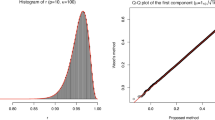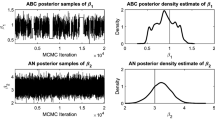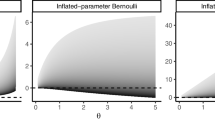Abstract
Let SPd be the class of all multivariate sign and permutation invariant densities and SPD be the corresponding class of distribution functions. The class of all distributions corresponding to a positive power of the members of SPD is called the Power Skew Symmetric class of distributions and it is denoted by PSS. We consider the problem of inference associated with the nonnegative power, in the PSS class, with a member of SPD as a nuisance parameter. As the structural forms of the members of PSS are not known, one can’t directly use the sufficiency, invariance, or likelihood function. Hence by using certain properties of the SPD and the PSS classes, we identify maximal statistics whose distributions depend only on the power but not on the members of SPD. We then use the concept of minimal dimensionality for retaining the information about the parameter of interest. We use the minimax criterion, which leads to a statistic having Binomial distribution depending only on the parameter of interest. Hence inferences about the parameter of interest can be carried out using the standard methods for the binomial model. A simulation study indicates that the proposed estimator of the power parameter is asymptotically normal and is insensitive to the nuisance parameter. The proposed method is implemented for the analysis of a data set.







Similar content being viewed by others
References
Arnold, S. F. (1985). Sufficiency and invariance. Stat. Probab. Lett.3, 275–279.
Azzalini, A. (1985). A class of distributions which includes the normal ones. Scand. J. Stat., 171–178.
Barndorff-Nielsen (2014). Information and exponential families: in statistical theory. Wiley.
Basawa, I. V. (1981). Efficient conditional tests for mixture experiments with applications to the birth and branching processes. Biometrika 68, 153–164.
Basu, D. (1959). The family of ancillary statistics. Sankhyā: Indian J. Stat., 247–256.
Basu, D. (1964). Recovery of ancillary information. Sankhyā: Indian J. Stat. 26, 3–16.
Basu, D. (1977). On the elimination of nuisance parameters. J. Am. Stat. Assoc. 72, 365–366.
Berk, R. H. (1972). A note on sufficiency and invariance. Ann. Math. Stat. 43, 647–650.
Cox, D. R. (1975). Partial likelihood. Biometrika 62, 269–276.
Durrans, S. R. (1992). Distributions of fractional order statistics in hydrology. Water Resour. Res. 28, 1649–1655.
Fernandez, C., Osiewalski, J. and Steel, M. F. J. (1995). Modeling and inference with υ-spherical distributions. J. Am. Stat. Assoc. 90, 1331–1340.
Gomez, H. W., Salinas, H. S. and Bolfarine, H. (2006). Generalized skew-normal models: properties and inference. Statistics 40, 495–505.
Gupta, R. D. and Gupta, R. C. (2008). Analyzing skewed data by power normal model. Test 17, 197–210.
Gupta, A. K., Chang, F. C. and Huang, W. J. (2002). Some skew-symmetric models. Random Oper. Stoch. Equ. 10, 133–140.
Hall, W. J., Wijsman, R. A. and Ghosh, J. K. (1965). The relationship between sufficiency and invariance with applications in sequential analysis. Ann. Math. Stat. 36, 575–614.
Johnson, R. A. and Wichern, D. W. (2014). Applied multivariate statistical analysis, vol 6. Pearson, London.
Justel, A., Peña, D. and Zamar, R. (1997). A multivariate kolmogorov-smirnov test of goodness of fit. Stat. Probab. Lett. 35, 251–259.
Kariya, T. (1989). Equivariant estimation in a model with an ancillary statistic. Ann. Stat., 920–928.
Koehler, E., Brown, E. and Haneuse, S. J. -P. (2009). On the assessment of monte carlo error in simulation-based statistical analyses. Am. Stat. 63, 155–162.
Landers, D. and Rogge, L. (1973). On sufficiency and invariance. Ann. Stat. 1, 543–544.
Lehmann, E.L. and Casella, G. (2006). Theory of point estimation. Springer Science & Business Media.
Mudholkar, G. S. and Hutson, A. D. (2000). The epsilon–skew–normal distribution for analyzing near-normal data. J. Stat. Plan. Inference 83, 291–309.
Pewsey, A., Gomez, H. W. and Bolfarine, H. (2012). Likelihood-based inference for power distributions. Test 21, 775–789.
Ramamoorthi, R. V. (1990). Sufficiency, ancillarity and independence in invariant models. J. Stat. Plan. Inference 26, 59–63.
Rattihalli, R. N. and Patil, P. Y. (2010). Generalized υ-spherical densities. Commun. Stat.—Theory Methods 39, 3568–3583.
Rattihalli, R. N. and Raghunath, M. (2019). Power skew symmetric distributions: tests for symmetry. In Proceedings of the Twelfth International Conference Minsk, September 18–22, 2019, pp. 104–113.
White, I. R. (2010). simsum: analyses of simulation studies including Monte Carlo error. Stata J. 10, 369–385.
Acknowledgments
I am grateful to the reviewers for their very useful comments which helped to improve the presentation and as well the content. I am also grateful to Professor M S Prasad for his suggestions, which have helped to improve an earlier version of the manuscript. Also thanks to S B Patil and S R Rattihalli for computing assistance.
I have not taken any financial support for this research work. This is an independent research work under taken by me; there are no conflicts of interest.
Author information
Authors and Affiliations
Corresponding author
Additional information
Publisher’s Note
Springer Nature remains neutral with regard to jurisdictional claims in published maps and institutional affiliations.
Appendix:
Appendix:
Proof Proof of Theorem 4.1.
For any finite positive integer k and r = 0,1, ...,k, let \(P\left (r,\ k\right )\) denote the probability of a quadrant with exactly r positive coordinates. Since variables are exchangeable, it is enough to show that
We shall use the method of induction and a recurrence relation. For any k ≥ 1 we have \(P\left (0,\ k\right )=P\left \{\mathbf {X}\le 0\right \}=G\left (0\right ){=\left \{F(0)\right \}}^{\alpha }={\left \{\frac {1}{2^{k}}\right \}}^{\alpha }={\left \{\frac {1}{2^{\alpha }}\right \}}^{k}\), that is
Let k = 1. Here X is a real random variable and from the above, \(P\left (0,\ 1\right )=\frac {1}{2^{\alpha }}\) hence \(P\left (1,\ 1\right )=1-\) \(P\left \{X\le 0\right \}=1-\) \(\frac {1}{2^{\alpha }}\). Thus result is true for 0 ≤ r ≤ k = 1.
For k = 2, since X1,X2 are exchangeable, the two quadrants {x1 ≤ 0, x2 > 0} and \(\left \{x_{1}>0,{\ x}_{2}\le 0\right \}\) have equal probabilities and we have \(P\left (0,\ 2\right )={\left \{\frac {1}{2^{\alpha }}\right \}}^{2}\). Now
Thus the result is true for k ≤ 2, r ≤ k. Suppose that the result is true for k ≤ t − 1, 0 ≤ r ≤ k. Let \(\mathbf {X}=\left (X_{1},\ {\ X}_{,\ \ 2},{{\dots } ,X}_{t}\right ). {\!}^{\prime }\sim G_{t;\ F,\ \alpha }\ \in PSSD(t),\) then we know that every l (≤ t) dimensional marginal distribution of X is a member of PSSD(l). That is \(\mathbf {X}^{\left (1\right )}=\left (X_{1},\ {\ X}_{2},{\dots , ,X}_{t-1}\right )^{\prime }\) and \(\mathbf {X}^{\left (2\right )}=\) Xt are respectively members of PSS(t − 1) and that of PSS(1). We have \(P\left (0,t\right )={\left \{\frac {1}{2^{\alpha }}\right \}}^{t}\) and \(P\left (1,t\right )=\) \(P\left \{X_{1}\le 0,\ {..,\ X}_{t-1}\le 0,\ \ X_{t}>0\right \} =\ \mathrm {\ }P\left \{X_{1}\le 0,\ {..,\ X}_{t-1}\le 0\right \}-Prob\left \{X_{1}\le 0,\ {..,\ X}_{t}\le 0,\right \}=P\left (0,\ \ t-1\right ) -\mathrm {P}\left (0,\ t\right ) ={\left \{\frac {1}{2^{\alpha }}\right \}}^{t-i}-{\left \{\frac {1}{2^{\alpha }}\right \}}^{t} ={\left \{\frac {1}{2^{\alpha }}\right \}}^{t-1}{(1-\frac {1}{2^{\alpha }})}\).
Suppose, by now we know \(P\left (i,t\right )\) for i = 0,1,2,,,r − 1 and \(P\left (i,j\right )\) for0 ≤ i ≤ j ≤ t -1. Consider
Since marginal distributions are members of PSS classes of appropriate dimensions, retaining the same value of α, from the above we have the recurrence relation
That is \(P\left (r,t\right ) ={\left \{\frac {1}{2^{\alpha }}\right \}}^{t-r}{\left (1-\frac {1}{2^{\alpha }}\right )}^{r-1}-{\left \{\frac {1}{2^{\alpha }}\right \}}^{t-r+1}{\left (1-\frac {1}{2^{\alpha }}\right )}^{r-1}\)\(={\left \{\frac {1}{2^{\alpha }}\right \}}^{t-r}\) \({(1-\frac {1}{2^{\alpha }})}^{r}\).
Hence the theorem.□
Proof Proof of Lemma 5.3.
For k = 2, let \(C_{1}=\{\left (y_{1},\ y_{2}\right ):y_{1}\ \le 0<y_{2}\ \le {-y}_{1}\}\) and \(C_{2}=\{\left (y_{1},\ y_{2}\right ):y_{1}\ \le 0<y_{2} >{-y}_{1}\}\) be the two disjoint non empty cones in \({\mathcal {C}}^{(2)}\) which are subsets of the quadrant \(Q=\{\left (y_{1},\ y_{2}\right ):y_{1}\ \le 0<y_{2}\ \}\). Now \( P\left \{\ C_{2}\ \right \}={\int \limits }^{0}_{-\infty }{\int \limits }^{\infty }_{-y_{1}}\ d F^{\alpha }\ \left (y_{1},\ y_{2}\right )\). By substituting y1 = − z2 and y2 = − z1, HCode \(P\left \{\ C_{2}\ \right \}={\int \limits }^{\infty }_{0} {\int \limits }^{z_{2}}_{-\infty }\ d F^{\alpha }\ \left ({-z}_{2},\ {-z}_{1}\right )\). By changing the orders of integrations we have \(P\left \{\ C_{2}\ \right \}= {\int \limits }^{0}_{-\infty }{\int \limits }^{{-z}_{1}}_{0}\ d F^{\alpha }\ \left ({-z}_{1},\ {-z}_{2}\right ), \ P\) \(\left \{\ C_{1}\ \right \}= {\int \limits }^{0}_{-\infty }{\int \limits }^{{-z}_{1}}_{0}\ d {F}^{\alpha }\ \left (z_{1},\ z_{2}\right )\).
Hence \(P\left \{ C_{2}\right \}- P\left \{ C_{1}\ \right \}={\int \limits }^{0}_{-\infty }{\int \limits }^{{-z}_{1}}_{0}\ d [{ F}^{\alpha }\ \left ({-z}_{1},\ {-z}_{2}\right )-{F}^{\alpha }\ \left (z_{1},\ z_{2}\right )]\).
But in the domain of the above integration, we have z1 ≤ 0 < z2 ≤−z1, and hence the point \(\left (-z_{1},\ {-z}_{2}\right )\) is coordinate-wise larger than the point \(\left (z_{1},\ z_{2}\right )\). Thus
and inequality is strict on a set of positive Lebesgue measure. Thus difference \(P\left \{\ C_{2}\ \right \}\)-\(\ P\left \{\ C_{1}\ \right \}\) depends on both α and F. But as the sum \(P\left \{\ C_{2}\ \right \}\) +\(P\left \{\ C_{1}\ \right \}\) is only a function of α, and hence both \(P\left \{\ C_{2}\ \right \}\) and\(\ P\left \{\ C_{1}\ \right \}\) depend on both α and F. □
The following results are used in Section 7.
Lemma A.1.
Let f, F be the density and the distribution functions of standard normal variate. Then function \(m\left (x \right )=1 + \left \lbrack \frac {\text {xF}\left (x \right )}{f\left (x \right )} \right \rbrack \) is strictly increasing and \(\lim _{x \rightarrow - \infty }{m(x)} = 0\), \(\lim _{x \rightarrow \infty }{m(x)} = \infty \).
Proof.
Consider \(m^{\prime }(x) = \frac {F\left (x \right )}{f\left (x \right )} + x\{ 1 - \frac {F\left (x \right )f^{\prime }\left (x \right )}{f\left (x \right )f\left (x \right )}\} = \frac {F\left (x \right )}{f\left (x \right )} + x\{ 1 + x\frac {F\left (x \right )}{f\left (x \right )}\} = \frac {F\left (x \right )}{f\left (x \right )}\left \{ 1 + x^{2} \right \} + x\). Hence \(m^{\prime }\left (x \right ) > 0\) for x > 0.
Now forx < 0, we have
That is, \((1 + \frac {1}{x^{2}}){\int \limits }_{- \infty }^{x}{e^{{- u}^{2}/2}du > \ }\frac {- 1}{x}e^{{- x}^{2}/2},\) implies that
and hence \({ \ m}^{\prime }(x)\) > 0. Hence \(m\left (x \right )\) is strictly increasing.
It is easy to check that \(\lim _{x \rightarrow \infty }{m(x)} = \infty \).
Further for x < 0, from Eq. 6 we have \(\frac {\left (1 + x^{2} \right )F\left (x \right )}{xf\left (x \right )} < - 1\). Now
Thus \(\lim _{x \rightarrow - \infty }{m(x)}= \lim _{x \rightarrow - \infty } \{1 + \left \lbrack \frac {x F(x))}{f(x)} \right \rbrack = 0\).
Hence the Lemma. □
Lemma A.2.
If \(f\left (x \right ) = \frac {1}{\sqrt {2\pi }}e^{- x^{2}/2}\) then the density function g(x,α) is unimodal and the mode is the unique solution of \(1 + \left \lbrack \frac {\text {xF}\left (x \right )}{f\left (x \right )} \right \rbrack \) = α.
Proof.
If \(f\left (x \right ) = \frac {1}{\sqrt {2\pi }}e^{- x^{2}/2}\) then we have
Hence from the Lemma A.1, for any α > o, the function \(g^{\prime }\left (x, \alpha \right ) \) changes the sign only once, that too from positive to negative. That is g(x,α) is increasing for x < m0(α) and decreasing for x > m0(α). Hence the Lemma. □
Rights and permissions
Springer Nature or its licensor holds exclusive rights to this article under a publishing agreement with the author(s) or other rightsholder(s); author self-archiving of the accepted manuscript version of this article is solely governed by the terms of such publishing agreement and applicable law.
About this article
Cite this article
Rattihalli, R.N. A Class of Multivariate Power Skew Symmetric Distributions: Properties and Inference for the Power-Parameter. Sankhya A 85, 1356–1393 (2023). https://doi.org/10.1007/s13171-022-00292-5
Received:
Accepted:
Published:
Issue Date:
DOI: https://doi.org/10.1007/s13171-022-00292-5
Keywords and phrases
- Symmetry
- Skew symmetry
- Nonparametric and semiparametric classes of distributions
- MLE
- UMP
- UMPU tests and simulation.




